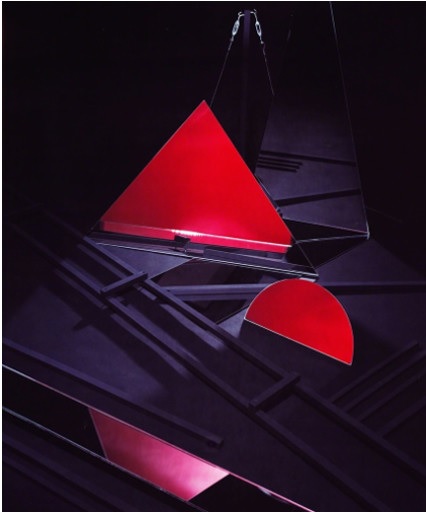
Barbara Kasten
American, 1936-
Construct PC-VI, 1982
polacolor
26 3/8 x 20 3/4 in.
SBMA, Gift of Arthur and Yolanda Steinman
1983.69.73

Barbara Kasten (Photo courtesy of Nick Ravich)
"When I make a photograph, it’s not in the traditional style of using a camera to capture reality or to catch a fleeting moment of life. I use the camera to document a moment, but everything that it records is something that I’ve made with my hands. "
- Barbara Kasten
COMMENTS
The ground floor galleries of the Institute of Contemporary Art currently house “Stages,” the first and sorely overdue survey of Barbara Kasten’s photography-based, multi-medium practice. As a prismatic allusion, the show’s title bundles the themes of the exhibition: the theatricality of Kasten’s expansive process, the iterations of her always playful engagement with surface and space, and the phases constituting her lengthy career. The show ties together some 50 years through roughly 80 works—predominantly photography, though video, installation, sculpture and painting are also represented—masterfully maintaining a visual density that alternately teases and rewards a curious eye.
“Stages” contains a number of pieces from Kasten’s iconic photographic series “Constructs” (1979-86), displayed alongside examples from the more recent series “Studio Constructs” (begun in 2007). Both bodies of work involve a combination of performance and installation. For each piece, she placed a camera in front of an arrangement of objects in her studio, including handmade props in plaster and wood, and industrially manufactured items like mirrors, rods, and aluminum siding. Instead of manipulating the camera, she animated the grouping either by physically guiding the objects’ postures or by varying the light and color with gels or scrims. The resulting images are pleasurably disorienting. The coyly wavy line that slices diagonally across Construct XXVII (1984) does not immediately yield its source (prop, texture, shadow?), nor do the stacked peaks of black and white triangles (reflection, light, pigment?) in Studio Construct 8 (2007). Strong and nuanced exemplars of Kasten’s pictorial grammar, the two series destabilize our assumptions about the visual properties of mass and light, reflectiveness and transparency, surface and edge—all the while indulging in the expressive potential of these qualities.
- Serena Qiu, "Barbara Kasten", Art in America, Reviews, Apr. 17, 2015
http://www.artinamericamagazine.com/reviews/barbara-kasten/
SBMA CURATORIAL LABELS
Focusing on painting and textiles for her B.A. and M.F.A degrees, Barbara Kasten has over the past five decades created engrossing photographs of still-life-like tableaus that are both visually vibrant and rigorously conceptual. Her work, subject of an important 2015 retrospective at the Institute of Contemporary Art, Philadelphia, intriguingly investigates intersections of photography, sculpture, color, light, and perception. Kasten builds her tableaus with three-dimensional geometric objects, and strategically places mirrors and sources of colored light in and around them. She then photographs these built scenarios in a straightforward manner with no manipulation of the traditional photographic process.
Undeniably precise yet depicting situations we don’t immediately grasp as “real,” Kasten’s photographs upend any balanced sense of how we expect objects to appear in rational space. Kasten challenges photography’s truth-telling mythos, not by any reworking of the negative or mechanical adjustments of the camera, but by making her complex constructions look unreal and impossible to the eye even before she photographs them. In probing the intertwined limits of abstraction, representation and the camera, Kasten follows in the line of early 20th-century German Bauhaus artists and Russian artist László Moholy-Nagy.
Two Kasten photographs on view represent the artist’s best-known work in this vein. "Construct PC-VI" is particularly alluring to the eye and constitutes a "tour-de-force" in the creation of ambiguous relationships between forms in planar space. By contrast, other works installed here are atypical for the artist. In an untitled 1979 photograph, Kasten deploys a white, grey and silver palette in the classic gelatin silver process, rather than her well-known saturated colors, in a work that suggests panes of glass, or natural phenomena such as water and ice. The "Roman Amphitheater" photograph is a fantastical image of something Kasten did not construct—a building, though real, which looks utterly transformed by what appears a negative reversal process into a radiating vision or dream. Together these works demonstrate the vast range of Kasten’s visual imagination and powers of execution.
- Crosscurrents, 2018
